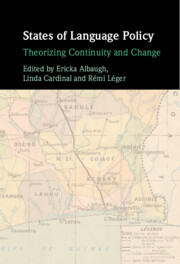Book contents
- States of Language Policy
- States of Language Policy
- Copyright page
- Contents
- Figures
- Tables
- Contributors
- Acknowledgments
- Introduction
- Part I Routes of Change
- Part II Dependent Relationships
- Part III Levels of Governance
- 11 Indigenous Reconciliation and the Limits of Canada’s Language Regime
- 12 State Tradition and Language Revitalization in Wales
- 13 Language Regime Change and Europeanization
- 14 Language Regimes, Global English, and National Public Education
- Conclusion
- Index
- References
11 - Indigenous Reconciliation and the Limits of Canada’s Language Regime
from Part III - Levels of Governance
Published online by Cambridge University Press: 14 November 2024
- States of Language Policy
- States of Language Policy
- Copyright page
- Contents
- Figures
- Tables
- Contributors
- Acknowledgments
- Introduction
- Part I Routes of Change
- Part II Dependent Relationships
- Part III Levels of Governance
- 11 Indigenous Reconciliation and the Limits of Canada’s Language Regime
- 12 State Tradition and Language Revitalization in Wales
- 13 Language Regime Change and Europeanization
- 14 Language Regimes, Global English, and National Public Education
- Conclusion
- Index
- References
Summary
For over fifty years, Canada’s language regime has centered - in theory, policy, and practice - on a binary: linguistic duality and authority of the two settler colonial powers, English and French. The legislative enshrinement of status for these colonial languages, by way of the 1969 Official Languages Act, has on most accounts failed in multiple ways. As is well documented, legislated equality between French and English has rarely manifested itself in practice. Less attention - scholarly or political - has been paid to the Indigenous languages erased by both political discourse and public policy in Canada. What limited policy attention there has been has focused on Indigenous languages as second languages. The development of the Canadian Parliament’s Indigenous Languages Act, launched by the Government of Canada on December 5, 2016, attempted to fill this gap. Analysis of this process reveals the tensions within Canada’s established language regime, while putting into sharp relief the difficulties of policy and policymakers to attend to - and move beyond - Canada’s colonial past and framework.
- Type
- Chapter
- Information
- States of Language PolicyTheorizing Continuity and Change, pp. 209 - 224Publisher: Cambridge University PressPrint publication year: 2024

